Bamboo Resource
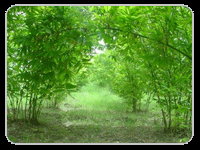
Odisha is like an oval shaped land mass on the eastern coast of India, extending from 170 49 N to 220 34 N latitude and from 810 29 e to 870 29 E longitude. The total geographical area of the State is about 1,55,707 square kilometres. It has 30 districts, 59 sub-divisions and 324 development blocks.
Odisha has 9% of the Countrys total bamboo forest cover and 7% of total growing stock of Bamboo. The bamboo in forest areas of Odisha grows as mixed crop associated with Sal & other species. The mixed bamboo forest area is spread over about 17,795 Sq. Km. and pure bamboo forest
( occurring mostly as bamboo brakes) is about 375 Sq.Km. There are about 13 species of bamboo available in Odisha of which most commonly found are Dendrocalamus strictus ( 80%), and Bambusa bambos (10%). Cultivated species are Bambusa vulgaris & Bambusa nutans. Bambusa tulda, Dendrocalamus lorgispathus, Schizostachyum pergraicile, Thyrostachys oliveri & Gigantachloa rostrata are occurring in localized area in different parts of State. Others (Thirostachys regia, Dendroclamus giganteous, Bambusa striata, Bambusa wamin) are occurring in Silvicultural & other bambusetum as representative plantation.
The production of bamboo is approximately 2 lakh MT annually of which about 50,000 MT is produced from the private land. The cultivated species (Bambusa vulgaris & Bambusa nutans) though occur throughout the state but density is significant in Mayurbhanj, Balasore & Bhadrak district.
Physiographic ally, the state can be divided into four regions:
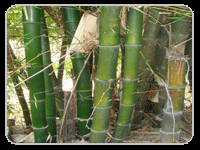 Coastal Plains: The coastline of Odisha stretches over 529 kms. The alluvial delta of six major rivers, namely the Mahanadi, Subarnarekha, Budhabalanga, Baitarani, Brahmani and Rusikulya form the fertile coastal plains and the marshy creeks.
Coastal Plains: The coastline of Odisha stretches over 529 kms. The alluvial delta of six major rivers, namely the Mahanadi, Subarnarekha, Budhabalanga, Baitarani, Brahmani and Rusikulya form the fertile coastal plains and the marshy creeks.
Central Mountainous Region: The central mountainous portion with its rolling hills and sprawling valleys covers about three fourths of the State.
Eastern Ghats:
The Eastern Ghats are uplifted in three successive stages with distinct cross section having average summit level of 900, 600 and 300 metres. The Eastern Ghats run from northeast to southwest.
Northern Plateau The high plateaus that are found in the mountain ranges have average elevation of 300-600 metres and represent characterstics of the peninsular tablelands
The recorded forest area of the state is 58,135 square kilometres; 37.34% of the total geographical area. However, the Reserve Forests, managed by the Forest Department, accounts for only 26,329 square kilometres. The balance forest areas are classified under Demarcated Protected Forests (11,685 square kilometres ) and Undemarcated Protected Forests (3,838 square kilometres). As per the State of Forest report, 2001 published by the Forest Survey of India (based on assessment through satellite imagery), the State has 27,972 sq.kms of dense forests, 20,866 sq.kms of open forests and 5,782 sq.kms of scrub forests.
The major species occupying the Odisha forests are Sal, Teak and Bamboo. The species wise classification of forests of the state are:
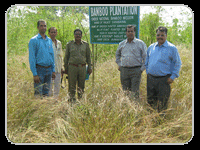
| Sal forest | 16,938 square kilometres |
| Miscellaneous forest | 21,024 square kilometres |
| Eak forest | 2030 square kilometres |
| Pure bamboo forest | 374 square kilometres |
| Mixed bamboo forest | 17,794 square kilometres |
| Mangrove forests | 219 square kilometres |
The bamboo species available in Odisha can be broadly classified in to four different categories:
:: Occurring naturally in the forests : Dendrocalamus strictus (Salia), Bambusa bambos (Daba)Bamboo Management in Forests of Odisha
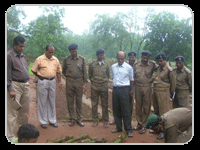
Bamboo occurs in large tracts of forests of Odisha except for the district of Mayurbhanj, Keonhar and Nawarangpur. It occupies about 13.950 Sq.Kms. of forests as an associate of sal, teak and miscellaneous crop. In general D.strictus occurs on the hill slopes where as Bambusa bambos occupies the moist area and nala banks. For ages together forest bamboo in Odisha was managed and exploited to meet the raw material requirements of the paper mills. Longterm leases were granted to the paper mills till 1st October 1988, when the forest bamboo was nationalized to be harvested and marketed by the state and its Agency. Even after that, 98 percent of bamboo, extracted from the state forests, were supplied to paper mills. Due to sole dependency on the paper mills, the state has to face a marketing problem in 2001. One of the major consumers, the Orient Paper Mills was closed down and for other paper mills, the sale price fixed by the Govt. was uneconomic. Such a situation virtually stopped the exploitation of bamboo for three years, as the agency was not tuned to market the bamboo other-wise. The delay in revision of management plans (Forest Working plans) for a number of Forest Divisions also added to the problem of harvesting bamboo from forests.
The basic principles of bamboo management centers round the growth behaviors of the culm. New bamboo culms are produced every year from the buds of the rhizome of previous year culm. The rhizomes of more than two-year-old culms, therefore, have very little role to play in production of new culms. However, bamboo culms require about three years to be fuly matured after which those are to be harvested.
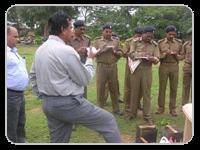
Retention of old culms will result in congestion of the clump. After 4-5 years the old culms will dry up, split and invite pests and disease, which will ultimately affect the younger culms. Congestion of clumps in one of the most serious problems in management of bamboo forests. Therefore, in India, for most of the bamboo forests, the prescribed cutting cycle is kept at 3 or 4 years.
However, the rural artisans are habituated in using 1-2 year old culms for ease of preparing slivers. This has resulted in damage of clumps due to poor growth of rhizomes after removal of the young culms. The 3-4 year old culms, harvested from forest by the department, are not suitable for their purpose due to its hardness. A via media has to be developed.
The artisans are to be trained / facilitated to use two-year-old culms and the management principle has to accommodate for harvesting of these culms to stop the menace of illegal cutting of young culms.
Bamboo in Odisha is managed under Culm Selection-cum-Clump Improvement Silvicultural System. A revised prescription for forest bamboo working in Odisha was approved in 1990 by the Chief Conservator of Forests, Eastern Regional Office, Ministry of Environment of Forests, Government of India, Bhubaneswar vides their letter no. 13/FCWP/UC-Gen.dated 24.12.1990 and communicated by the Principal Chief Conservator of Forests, Odisha vide Memo No. 26951(4) dated 28.12.1990. The commercial exploitation of bamboo from forests within the Wildlife Sanctuaries has been stopped by the State Government from 1997. The approved management prescriptions are appended as Appendix - A. In order to improve the growth and productivity of bamboo crop, regular cultural operations are to be carried out. The management principles recommend the following silvicultural operations in bamboo forests immediately after harvesting of bamboo at an interval of four years.
Current Policy on Bamboo
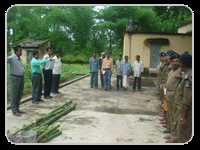
Bamboo working in Odisha has been nationalized since 01.10.1988. The state Govt. have appointed the Odisha Forest Development Corporation Ltd. as the sole Agent for extraction and trade in bamboo all over the state. The O.F.D.C. Ltd. extracts bamboo from forests in form of industrial bamboo bundles for the paper mills and long bamboos (Commercial bamboo) for house hold uses. The paper mills of Odisha are the main users of bamboo extracted from forests. Only about five percent of the total harvest is extracted as long bamboos for household and artisan activities.
The measurement unit for industrial bamboo has been the Sale Unit (SU), notionally equivalent to one MT in weight. Salia bamboo of 2400 m running length constitute one Sale Unit. Salia bamboos are cut in to pieces of 2.3 m length having not less than 4 cm girth at thin end and made in to bundles of 21 pieces each to from a full bundle. Smaller pieces of more than 75cm long are also made in to bundles of 21 pieces each to form a half bundle. Thus, 49.689 full bundles of Salia constitute one Sale Unit of industrial bamboo. In case of Daba bamboo (Bambusa bamboos) a full bundle contains 7 pieces of 2.3 m long each. 149.7 full bundles of Daba bamboo make one Sale Unit. However, for the purpose of sale price one Sale Unit of Daba bamboo is treated as equivalent to 2.5 Sale Unit of Salia bamboo. Notionally, 350 numbers of long (Commercial) Salia bamboo is taken as one Sale Unit.
The State Govt. have constituted one high power committee designated as the Empowered Committee under the chairmanship of the Chief Secretary, Odisha to decide the model of disposal of both industrial and commercial bamboo harvested from forest. The Empowered Committee annually decided the target of production, allotment of industrial bamboo to different paper mills of the state, expenditure norm, royalty to be paid to Govt. and also the sale price for both industrial and commercial bamboo.
Recorded Bamboo harvest from Forests during last two decades
| Year | Yield in lakh \ MT | Royalty received by the State (Rs.in Million) |
| 1980-81 | 3.48 | 23.55 |
| 1981-82 | 3.02 | 26.53 |
| 1982-83 | 2.95 | 21.59 |
| 1983-84 | 2.63 | 24.32 |
| 1984-85 | 3.88 | 30.88 |
| 1985-86 | 2.89 | 30.90 |
| 1986-87 | 2.15 | 29.97 |
| 1987-88 | 2.54 | 30.00 |
| 1988-89 | 2.61 | 75.93 |
| 1989-90 | 2.39 | 78.95 |
| 1990-91 | 2.20 | 74.55 |
| 1991-92 | 2.38 | 82.56 |
| 1992-93 | 2.45 | 87.31 |
| 1993-94 | 2.41 | 101.14 |
| 1994-95 | 2.40 | 103.50 |
| 1995-96 | 2.18 | 95.31 |
| 1996-97 | 2.46 | 90.00 |
| 1997-98 | 2.08 | 85.00 |
| 1998-99 | 1.20 | 85.00 |
| 1999-2000 | 1.12 | 20.00 |
(Sources - The bamboo of Odisha forest department Govt. of Odisha.)
| Year | Yield in lakh \ MT | Rate of royality | Royalty received by the State (Rs.in Million) |
| 2000-01 | 7436(su) | 677/- | 4.81 |
| 2001-02 | No corency | - | - |
| 2002-03 | 210(su) | 350/- | .07 |
| 2003-04 | 15427(su) | 350/- | 5.39 |
| 2004-05 | 82804(mt) | 500/- | 41.40 |
| 2005-06 | 124037(mt) | 500/- | 62.01 |
| 2006-07 | 97357(mt) | 500/- | 48.67 |
| 2007-08 | 105188(mt) | 500/- | 52.59 |
(Sources - Odisha forest development Corporation Ltd.)
The above production figures only indicate the bamboo extracted from forests by the lessees (up to 1987-88) and the Odisha Forest Development Corporation Ltd. Apart from the recorded harvest, substantial quantity of bamboo is also felled and removed from forests by local people and artisans for house hold use and occupational livelihood. However, no estimation has been made to assess the total annual harvest of bamboo from forests.
The Future Prospective
Bamboo is one of the most abundant and renewable resources available in Odisha covering nearly 30% of the total forest area of the state. Presently the use of bamboo form forests for its major industrial use i.e. paper manufacturing, is decreasing. The lack of demand for bamboo by paper mils has resulted in non-disposal of harvested bamboo by the Odisha Forest Development Corporation Ltd. This has adversely affected the livelihood opportunities of rural communities and forest fringe dwellers, who were previously engaged in extraction of forest bamboo. However bamboo has the potential for generation of gainful employment through various bamboo-based industries which can be developed on the technological advancements made in India and other countries. It offers tremendous employment and income generation opportunities to the community for the invaluable role they can play covering harvesting and regeneration, treatment and other value addition options linked to various industrial products. Considering the situation, the state had engaged IPIRTI, as Research and Training Institute of the Ministry of Environment & Forests, Government of India to prepare a comprehensive action plan for alternate industrial uses of bamboo produced in the state. Preliminary findings of the study suggest that Odisha bamboo is suitable for mat based products and the people posses adequate basic skills for weaving mats that can be upgraded through hands-on training. In collaboration with INBR and IPIRTI, the Odisha Forest Department has organized a two-day state level workshop at Bhubaneswar on 28-29 January 2004, with a view to initiate the process of sensitizing various stakeholders.
The consensus of outcome of the workshop was for establishment of an apex body in the state to harness the potential of bamboo sector for poverty alleviation in the state. Accordingly, a proposal for constituting Bamboo Development Mission is under active consideration of the state government.
Government of Odisha intends to constitute the Odisha Bamboo Sector Development Mission for strategic planning and implementation of schemes and programmes for sustainable management of bamboo resources in the State and to develop based livelihood system and manufacturing value added bamboo products with the following objectives :
Enhancement of Productivity
In the descending order of commercial importance, bamboo species available in Odisha can be listed as : 1. B. nutans, 2. B. vulgaris, 3. B. tulda, 4. B. bambos, and 5. D. stictus. But the last one i.e. D.strictus(Salia bamboo) accounts for almost 90% of bamboo resource of the state. This resource is also depleting very fast in certain regions of the state due to increasing demand and consequent over cutting. The demand is met by cutting young bamboos particularly one-year-old culms. Removal of young culms hampers the growth of current year rhizome, which cause the progressive degradation of the clump. The number and size of new culm is reduced year after year and ultimately the clump is reduced to a bush producing only finger thick shoots. Large chunks of bamboo forests of the state have been degraded to such unproductive crop. This situation calls for an immediate inventory of the resource and management intervention to improve the stock. The Salia bamboo (D.strictus), which forms the major portion of the bamboo resource, has many variants. In some regions of the state the quality of the crop is very low; the culms are thin, short length and at times hollow. Study is required to ascertain whether this low quality is due to genetical variation rod due to bio-edaphic factors. Variation in growth 7 productivity is also observed in B.vulgaris, the species cultivated by the villagers. Selection of superior clones and their propagation will certainly improve the resource. This will involve both in-situ and ex-situ conservation of germplasm, their evaluation and multiplication.
However, such Seed Production Areas can be identified for the salia bamboo only. Since this species grows gregariously in Govt. forests and produce seeds periodically by sporadic flowering. In case of other species, superior clones are not found in compact patches. Most of these clumps are occurring in private lands, in scattered locations and hence in-situ conservation is not possible. These superior clones are to be identified, collected and vegetatively propagated to create large number of Bamboo Multiplication Gardens.
The important morphological characters to be considered for selection of superior genotypes of a species are :
 :: Age group-wise number of culms in the clumps
:: Age group-wise number of culms in the clumpsInitially large number of Candidate Plus Bamboo Clumps (CPBC) are to be selected by conducting inventory through out the state. The growth parameters are to be recorded annually for a period of at least 3 years. After analyzing the growth records final selection of superior bamboo clones (Plus Clumps) of a particular species will be made. The finally selected ones are to be assigned a clone number to facilitate future reference.
To conserve the genotype and to ascertain the hybrid vigour of these clones, Germ Plasm Banks are to be established. Progeny trials are to be conducted in different agro climatic zones of the state by producing propagules through vegetative propagation methods. Field trials are to be conducted to test the variation in growth and productivity.
Cultivation models including inter-cropping methods are to be standardized for different bamboo species for different regions of the state. The degraded bamboo forest areas are to be rejuvenated by improved cultural practices. In some areas it can be replaced by planting high yielding superior genotypes (clones) of commercially more important species to enhance the productivity.
The following activities need immediate consideration for improvement of the resource base :
Bamboo is Commercial Crop
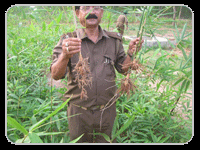
Bamboo holds the potential to be a vehicle for economic growth for the people of Odisha. In terms of uses, it is already playing a leading role addressing the needs of rural housing, basketery, handicrafts and other utility items with more options likely to emerge in future. The cultivation of bamboo needs to be encouraged. The National Bank for Agriculture and Rural Development (NABARD), is promoting a number of projects for bamboo cultivation / plantation in different states under its Forestry / Agroforestry programmes. The Odisha Regional Office of NABRD has approved schemes for cultivation of pure bamboo crop of Bambousa vulgaris, Bambusa nutans and Dendrocalamus strictus. Besides, farm forestry projects for cultivation of Bamboo with Teak and Bamboo with Eucalyptus are also financed by NABARD.